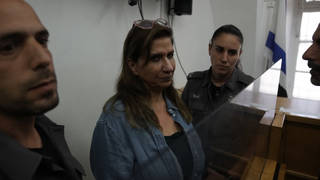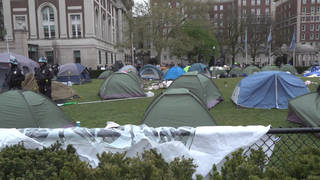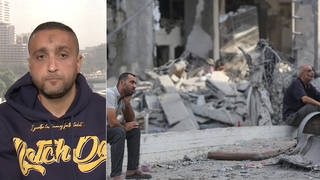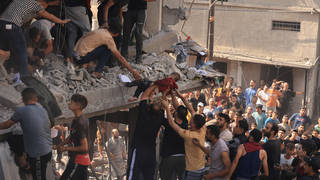
Related
Topics
We go to Sri Lanka and Thailand for on-the-ground reports from nations devastated by massive tsunamis caused by the world’s largest earthquake in 40 years. [includes rush transcript]
More than 20,000 people have died across southern Asia after a massive earthquake in the ocean set off a series of tsunamis. More than one million people have been left homeless. Scientists said the earthquake registered at a magnitude of 9.0 making it the world’s largest earthquake in four decades.
Hardest hit were Sri Lanka, Indonesia and India. More than a thousand died in Malaysia, Maldives, Bangladesh. At least nine people even died in the eastern coast of Somalia some 3,000 miles from the earthquakes epicenter.
The earthquake generated waves as high as 40 feet that swept across the Indian Ocean.
The head of Italy’s National Geophysics Institute said the earthquake was large enough to disturb the Earth’s rotation. He said “All the planet is vibrating” from the quake.
Some scientists say the catastrophic death toll might have been reduced had India and Sri Lanka been part of an international warning system designed to warn coastal communities about potentially deadly tsunamis. The Wall Street Journal reports a tsunami of this size is unprecedented in the Indian Ocean.
The U.N.’s Emergency Relief Coordinator Jan Egeland told CNN that the worse may still to come from disease and epidemics. He said, “The longer term effects may be as devastating as the tidal wave or the tsunami itself.”
- John Aglionby, reporter for the Guardian of London. He has been reporting on the earthquake from Indonesia and Thailand. He is speaking to us from the Thai city of Phuket.
- Emile Okal, professor in the Department of Geological Sciences at Northwestern University.
- Mervyn Perera, member of disaster unit of the Red Cross in Colombo, Sri Lanka.
Transcript
AMY GOODMAN: We turn first to John Aglionby, a reporter from The Guardian of London, who has been reporting on the earthquake from Indonesia and then got on a plane to Thailand. We reached him just before the program. He is speaking to us from Phuket Island.
JOHN AGLIONBY: I’m on the southern tip of Phuket, Thailand, on one of the three beaches that were devastated by the tsunami yesterday.
AMY GOODMAN: Can you talk about what you see there?
JOHN AGLIONBY: A scene of complete devastation along the beachfront. There’s only one building that I know out of hundreds that is at all intact. How that survived I really don’t know. We have cars stacked two or three on top of each other. We have cars that have been thrown hundred of meters down the streets into shops. There’s nothing intact whatsoever. Its as if a herd of massive elephants have come through, trashing everything and throwing it left, right and center. The rescuers are absolutely shattered. I have met some of them in the hospital. They’re saying they have been pulling dozens of bodies from buildings and from the streets and expecting more bodies to be washed ashore tomorrow. The authorities here are completely overwhelmed. The hospitals don’t have enough medical equipment. They don’t have enough bandages. They don’t have enough medicine. The supplies are not coming in through Bangkok. The scene of the airport is equally as chaotic. Thousands of foreigners are trying to get out. Many spent last night camped in the mountains. The hotels are wrecked or they were afraid of further earthquakes or tsunamis. They believe that they have essentially had enough and they want to get out, but it’s not as easy as that. Some people are preparing to sleep in the airports tonight if they can’t get flights out. They are desperate to go, and it’s overwhelming.
AMY GOODMAN: John, what is — what are the casualties there?
JOHN AGLIONBY: Hard to tell. In Thailand we’re at 900 now and thousands injured. In Indonesia, I’m hearing, which is where I came from today, that the death toll is about 4,500, and rising. They still haven’t got to the area closest to the epicenter of the earthquake. The western tip on the northern coast of Sumatra. That’s days ahead. Here in Thailand. They are saying it’s an unprecedented natural disaster. They’ve never had anything like it before. They’re caught completely unprepared, and they expect the casualty figures to rise.
AMY GOODMAN: What about aid? Is aid getting to people? To communities where you are?
JOHN AGLIONBY: I haven’t seen masses of aid arrive yet. There are certain crews cleaning up. Where the crews came from, I don’t know and who organized them. There were a couple of foreign aid people on the plane with me today flying in. And in Indonesia, it’s an even more sketchy picture because the province where the quake struck is closed to foreign aid agencies because of the separatist insurgency there. The latest news we have today is the aid has been offered, but the government still hasn’t formally accepted it. They don’t want foreigners meddling in their insurgency wrecked area. It’s a patchy picture at best as far as aid is concerned. In many areas it’s not getting there at all.
AMY GOODMAN: Some scientists say that the catastrophic death toll might have been reduced had there been an international warning system, is that your sense?
JOHN AGLIONBY: Yes it is. I have bumped into one person who actually said he had heard of someone else who got a warning from a friend in Switzerland of all places that there had been an earthquake and he should expect a tsunami. There was clearly one anecdotal piece of evidence that a warning system could have made a difference and this person got off the beach and escaped to high land. If there was something formal then yes, clearly, hundreds if not thousands of lives would have been saved.
AMY GOODMAN: How, John, did you get from Indonesia to Phuket Island?
JOHN AGLIONBY: Easily, surprisingly easily. Got on a plane in Jakarta and changed in Singapore and landed here. We had to circle for an hour in the air before landing because the Phuket airport is so busy. There were so many planes trying to evacuate stranded foreigners out of there. But apart from that we managed to get in. Its just a logjam on the runway.
AMY GOODMAN: One last thing, have you seen any evidence of the United Nations there?
JOHN AGLIONBY: No, none whatsoever. I have been on the worst effected beach and perhaps they have been operating in other areas, but where I was, no evidence whatsoever.
AMY GOODMAN: John Aglionby of The Guardian of London just flew into to Phuket Island from Indonesia. This is Democracy Now!
[break]
AMY GOODMAN: We turn to Dr. Emile Okal, who is a professor in the Department of Geological Sciences at Northwestern University. Welcome to Democracy Now!
DR. EMILE OKAL: Hello.
AMY GOODMAN: Can you talk about what has just taken place?
DR. EMILE OKAL: Well, what has just taken place is an earthquake that most of us would not and did not expect. It is the largest earthquake in 40 years, which happened in a place where apparently such earthquakes can be expected, but it had been such a long time that there was no documented instrumental record of an earthquake in that location. Although some of my colleagues are doing some field work. They have been doing field work and have documented geological evidence for the earthquake, but the recurrence is probably only 400 or 500 years in the that location.
AMY GOODMAN: Can you explain exactly what has taken place?
DR. EMILE OKAL: Well, a major earthquake, which is among the largest that is known on the earth! And that earthquake has killed apparently — along a fold ,which is 1,000 kilometers long. In so doing, it has shaken the bottom of the ocean and unleashed motion in the ocean on a very large scale, which has resulted in waves inundating both locally Indonesia, the islands, Malaysia, Thailand and so on, across the bay of India, and Sri Lanka.
AMY GOODMAN: Can you talk about the difference with how countries are prepared around the Pacific Ocean versus the Indian Ocean?
DR. EMILE OKAL: Well, I know very little about the situation in the Indian Ocean, but I would think that there are two aspects. First of all, because these events are relatively rare, there is little awareness on the part of the population for this kind of danger. So people build perhaps in unsafe areas, and also when people felt the earthquake, I imagine they did not have the immediate reflects of running away from the beach, something that people who live in shores where Tsunamis are more frequent are well educated to do both through formal education and through ancestral education with what their parents tell them, in a sense. The second point is that there is no Indian ocean-wide service, an international service to monitor earthquakes and issue Tsunami warnings as it exists in the pacific. Once again, it’s probably because of the very used frequency there.
AMY GOODMAN: We’re speaking to Dr. Emile Okal, professor in the department of Geological Sciences at Northwestern University. He’s actually speaking to us from Greece. The head of Italy’s national Geo-Physics Institute said that the earthquake was large enough to disturb the earth’s rotation. He said, “All of the planet is vibrating”.
DR. EMILE OKAL: Well, all of the planet vibrates even for smaller earthquakes. It is possible that it disturbs the earth’s rotation, which is an open topic. The jury is still out for much larger earthquakes, such as the Chilean earthquake, which was even bigger in 1960. I think the jury is still out. I would doubt very much that we would be able to come to a conclusion in this respect in 24 hours. But certainly, it’s a very exciting topic, and certainly many, many scientists are going to look very carefully in this respect. But if indeed it has reset things such as the wall, as we call it, we won’t know probably for another few weeks before we can make measurements of the earth’s rotation in a long enough period of time.
AMY GOODMAN: You mentioned what happened before in Chile in 1960 and in 1964 in Alaska. Can you describe what happened then?
DR. EMILE OKAL: Well, in Chile, there was an earthquake that was probably stronger from what I gather, and quite definitely so, did a lot of damage in Chile. I’m not exactly sure how many people were killed, but then the Tsunami crossed the pacific and killed 60 people in Hawaii and about 200 in Japan. However, there was some level of warning because of the very long time that it took for the waves to cross the pacific, and so in a sense, the people knew it was coming. In 1964, there was an earthquake in Alaska, which was greater than the one yesterday. It generated a local tsunami and did a lot of damage in some parts of Alaska, notably Seward, Alaska. And then there were waves, but because of the particular geometry of the fold, the longest of the waves were aimed not to the center of the pacific but to California, and it killed, if I’m not mistaken, ten people in California in Crescent city.
AMY GOODMAN: The UN’s emergency relief coordinator has said that the worst may be yet to come from disease and epidemics, saying that the longer term effects may be as devastating as the tidal wave or the Tsunami itself.
DR. EMILE OKAL: Well, I’m in no position to judge this, but it seems quite reasonable. Suddenly, when you have 15,000 people in tropical climates dead, there are enormous problems with disease and survival under those conditions.
AMY GOODMAN: Was this in any way — would it have been possible to predict this earthquake and Tsunami?
DR. EMILE OKAL: No. Absolutely not in terms of making a prediction which would have any value from a social standpoint. My colleagues, as I mentioned earlier on who are geologists working in Sumatra, can recognize in the past there were probably such earthquakes, 400, 500 years ago. They are in no position to say it’s going to come in the next year or ten years or tomorrow morning or anything like this. So, from the pure scientific point of view, yes, we were probably coming to a realization that this is an area that has major earthquakes and which has had them in the past, but from a practical standpoint of putting out a warning which can be used by society, the answer is no.
AMY GOODMAN: We’re speaking with Dr. Emile Okal. What have you heard as you monitor what is taking place, what is almost it sounds like ground zero, which is Banda Ache and Ache in Sumatra.
DR. EMILE OKAL: I hear very little since I’m on vacation in an extremely remote part of Greece right now. I rely on incompetent net connections and the occasional television program in Greek, which I don’t understand. You can figure out that I do not have much information at present on these aspects of things. As far as Banda Ache is concerned, I have some information. I do know that there is a lot of unrest in that area. And that’s about all I know.
AMY GOODMAN: Well, I want to thank you very much for being with us, Dr. Emile Okal, professor in the department of Geological Sciences at Northwestern University, speaking to us from Greece where he just happened to be on vacation. I want to thank you for being with us. Out of curiosity, what is the response where you are?
DR. EMILE OKAL: Oh, the response? I cannot judge much because the response in the villages I’m visiting is inexistent. The response on television, I cannot judge because it’s in Greek. I can tell you that yesterday evening all of the channels were showing the programs, which had to do with the earthquake and Tsunami. And I do have a colleague in Greece with whom have talked, and I know he is very, very busy talking to your colleagues, and on the spot.
AMY GOODMAN: Well, thank you very much for joining us. Dr. Emile Okal, as we turn now to Mervyn Perera. We reached him just before the program. He works with the Red Cross in Colombo, Sri Lanka.
MERVYN PERERA: Everybody is in the street. There are bodies in the street. There are a lot of dead bodies and most of the dead bodies have been covered by the houses falling onto them and as they clear the roads, all of the dead bodies on the roads are being put into these broken places, and it is very difficult to take out the dead bodies, but the relief workers are attempting to take these dead bodies, and they will remove them in another two or three weeks.
AMY GOODMAN: Mervyn Perera, working with the Red Cross in Colombo, Sri Lanka, one of the places hardest hit. The death toll continues to rise. This is Democracy Now!












Media Options